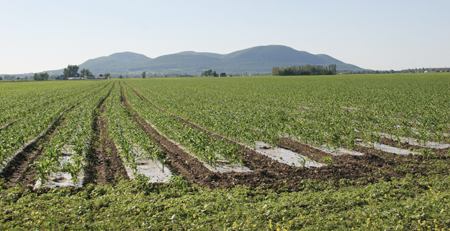
Features
Production
Research
Researchers developing biodegradable alternative to plastic mulch
March 13, 2008 By Marg Land
Plastic mulch films are used
extensively by growers in the vegetable industry for retaining
moisture, controlling weeds, warming the soil in early spring,
improving crop yield and quality and accelerating plant growth for
earlier harvests.
 |
| An example of horticultural plastic mulch use in a double row system of sweet corn. The cost to dispose of plastic films starts from $49 (US) per acre. |
Plastic mulch films are used extensively by growers in the vegetable industry for retaining moisture, controlling weeds, warming the soil in early spring, improving crop yield and quality and accelerating plant growth for earlier harvests.
But the challenge in using the films is the high cost of disposing of the used plastic.
“Getting rid of the used plastic is very expensive, and it’s an annual expense for vegetable growers,” says Dr. Mathieu Ngouajio, a horticulture scientist and assistant professor with Michigan State University. “Growers pay for labour to cover the fields with plastic and then to have it manually removed at the end of the season, loaded onto a truck and driven to the landfill, and then they have to pay the landfill to take the plastic. These costs are all in addition to the cost of growing the crop. Growers would really benefit from the creation of a biodegradable alternative.”
Dr. Ngouajio and his colleagues hope an interdisciplinary research project will help create more profitable production practices for these industries, as well as reduce the amount of plastic in landfills.
In 2005, Dr. Ngouajio presented a seminar highlighting research he’d been conducting since 2002 that evaluated various types of plastic mulches used by the vegetable industry. After describing the limitations he faced when disposing of the used plastic, Dr. Ngouajio was approached by Dr. Tom Fernandez, another horticulture scientist and assistant professor at MSU. Dr. Fernandez explained that the nursery and landscape industry was facing a similar dilemma – how to dispose of plastic used to cover growing crops and the tops of greenhouses. Dr. Ngouajio and Dr. Fernandez decided to work together to seek a solution for both industries.
Plastic mulch films are used on multiple vegetable crops in Michigan, including 11,600 acres of fresh market cucumbers, peppers and tomatoes. On this acreage alone, about 165 pounds of plastic is used per acre, for a total of 1.9 million pounds. The cost to dispose of the plastic films amounts to $49 (US) per acre, for a total of $568,400 (US).
“Disposal doesn’t only represent a huge expense to growers – it also adds nearly two million pounds of waste plastic to landfills, which is a real environmental concern,” Dr. Ngouajio says. “Our research is focused on developing a biodegradable mulch film that will help reduce grower expense and eliminate excess waste in our landfills.”
The scientists have focused their efforts on designing plastic that could be broken down by soil microbes. They’ve successfully developed three biodegradable mulch films that were field-tested on tomatoes last summer at and are now comparing the effect of the biodegradable material on crop performance and yield to that of conventional black plastic film.
“This is truly an interdisciplinary project,” Dr. Ngouajio said. “The chemists are evaluating the physical and chemical properties of the film to determine how they break down and change colour over time. The horticulture researchers are evaluating tomato yield, weed control and soil temperature, and so far, results (are) promising.”
Dr. Ngouajio says biodegradable mulch films will probably cost more than conventional films, but at the end of the use cycle, they’ll be a more profitable alternative.
“A biodegradable product will likely cost more to purchase, but it will be more environmentally friendly to use,” he says. “Biodegradable materials wear down in much the same way that cornstarch breaks down, so the film will be able to be broken down by the soil and won’t need to be dumped in landfills.”
Print this page